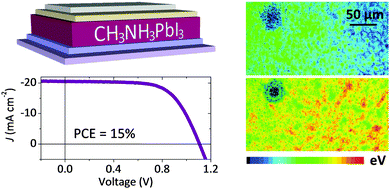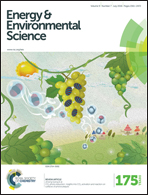Quantification of spatial inhomogeneity in perovskite solar cells by hyperspectral luminescence imaging†
Abstract
Vacuum evaporated perovskite solar cells with a power conversion efficiency of 15% have been characterized using hyperspectral luminescence imaging. Hyperspectral luminescence imaging is a novel technique that offers spectrally resolved photoluminescence and electroluminescence maps (spatial resolution is 2 micrometer) on an absolute scale. This allows, using the generalized Planck’s law, the construction of absolute maps of the depth-averaged quasi-Fermi level splitting (Δμ), which determines the maximum achievable open circuit voltage (Voc) of the solar cells. In a similar way, using the generalized reciprocity relations the charge transfer efficiency of the cells can be obtained from the hyperspectral images. Very strong inhomogeneity, both in quasi-Fermi level splitting (Δμ) and in charge transfer efficiency, are found in these vacuum deposited perovskite solar cells. This implies that these efficient solar cells are still far from perfect as many areas in the device do not or only partially participate in the photon to electron conversion processes.


 Please wait while we load your content...
Please wait while we load your content...